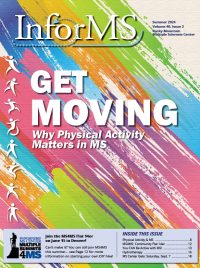
We know that exercise has a profound impact, not just on physical symptoms but on cognitive function and emotional wellness, too. Study after study show the science is clear: getting active on a regular basis can help slow brain atrophy, lift your mood, and help with many mobility issues. Regular exercise is a key factor in building resilience that can help lessen the impact of some physical symptoms, as well as promoting neuroplasticity – your brain’s ability to reorganize and rebuild nerve connections – a critical factor in long-term positive outcomes in MS.
Neurological reserve is a concept you may have read about in past issues of InforMS. It refers to the capacity of the brain to compensate for damage without loss of neurological function. When an injury, toxin or disease damages part of the brain, our neurological reserve helps the brain compensate and keeps us functioning normally.
Two components work together to function as neurological reserve: brain reserve is the passive part of the puzzle, describing physical characteristics like brain volume and number of neurons we possess; cognitive reserve is the active part, describing the ability of the brain to compensate for damage by activating pathways to make up for and avoid areas of damage.
Neuroplasticity is closely related to these concepts, and refers to the brain’s ability to compensate after damage has occurred. Neuroplasticity compensates for damage or injury by building new pathways and connections within the brain.
In simple terms, you can think of neurological reserve as the protection or defense of your central nervous system, while neuroplasticity is the rerouting mechanism that helps your nervous system cope after damage has been done.
So what does all this brain science have to do with exercise?
More and more, doctors and scientists are realizing just how big an impact physical activity has on brain health. Studies show that overall physical health – a key component of which is regular exercise – can have a direct impact on brain health.
As we age, our brain volume naturally decreases over time. Starting sometime around our late-20s, this decrease is a normal part of everyone’s aging process. When you’re living with MS, you’re dealing with damage caused by the disease in addition to this normal processes of aging.
The Rocky Mountain MS Center’s comprehensive care and treatment model puts a lot of emphasis on maximizing a person’s lifelong brain health – doing things we can, in conjunction with your MS treatment plan, to slow brain volume loss, protect cognitive reserve, and promote neuroplasticity.
One of the key components in the brain’s ability to protect and repair itself is a protein called Brain-Derived Neurotrophic Factor (BDNF). BDNF plays a vital role in the growth, health and maintenance of neurons in the brain and central nervous system. Think of it as a sort of a fertilizer for brain cells.
Studies have been mounting up in recent years showing that physical exercise increases BDNF production, boosting our brain’s ability to protect itself, compensate for damage, and possibly even slow down natural age-related brain volume loss.
Is physical activity going to cure MS? Unfortunately, that’s not the case — but it’s a critical component of an MS care plan.
But the benefits don’t stop there. Physical activity is also a powerful antidepressant, helping to elevate mood and counter the emotional weight of chronic illness. And when it comes to functional abilities, exercise can be a game-changer — improving strength, balance, coordination and cardiovascular health to help you go farther with more ease.
And it’s not just about MS. Comorbidities – those other conditions you may be dealing with in addition to your MS – can also be positively impacted by a regular exercise routine. Overall physical health that comes from regular activity can help stave off heart disease, diabetes, hypertension and a host of other conditions that can complicate life with MS and its symptoms.
Physical Activity in MS: How Much and What Kind?
According to the US Department of Health and Human Services, an average person should get 150 minutes of exercise per week. That recommendation is the same for people living with MS. But what exactly does “150 minutes of exercise” mean?
Not all exercise happens in a gym, at a physical therapist’s office, or during an intense run on a local track. The good news is that your regular daily activity can be part of your routine. The authors of “Exercise and Lifestyle Physical Activity Recommendations for People with Multiple Sclerosis Throughout the Disease Course,” published in 2020 in Multiple Sclerosis Journal, describe physical exercise as broken down into two types of activity:
Lifestyle Physical Activity – This refers to the normal activity we all accumulate over the course of the day. This can be household activities like gardening or yard work, household chores like laundry and sweeping, leisure like talking a stroll around the block, playing with children, talking pets for a walk… anything that gets you moving, moderately or intensely, as long as your heart gets pumping above a resting rate.
Exercise – Formal exercise refers to targeted, purposeful physical activity that you set out to do. It’s usually repeated over a period of time (an ongoing exercise routine), and undertaken with a specific objective or goal (improving or maintaining physical fitness, performance, or health).
The 150 recommended minutes per week can be a combination of these two, which means you may find that just your average, everyday life could put you a long way toward that seemingly difficult goal.
Additionally, that 150-minute goal doesn’t have to be made up of long, formal exercise sessions. Short periods of activity – 10 or 15 minutes at a time – added up count just as much as a single hour-long session at the gym.
It’s also important to note that the guideline of 150 minutes per week is a goal that should be worked up to gradually. If you haven’t been very active lately, set your sights on a manageable and attainable amount of weekly exercise time, with an intention to add more as you adjust to new activity levels. The benefit of this gradual approach is twofold: First, you’ll be better able to manage and stick with a new activity routine by starting with bite-sized changes to your current activity levels; and second, a gradual approach will help you build strength, stamina and endurance that will make a steady upward trend in your activity levels easier and safer for your body.
Barriers to Exercise in MS
While the benefits of exercise are clear, and a gradual, attainable approach can help get you started, that doesn’t address the very real difficulties many people living with MS experience in building a sustainable active lifestyle for themselves.
In fact, studies have shown that as many as 80% of people living with MS don’t get enough physical activity of one form or another.
One of the primary barriers to physical activity in MS is one of its most commonly-reported symptoms: Fatigue.
Fatigue can sound so innocuous – implying that someone is simply a little tired. But anyone who’s experienced significant MS-related fatigue knows that the symptom can be debilitating, manifesting as both physical and mental exhaustion that makes the energy and motivation needed for physical exercise next to impossible to muster.
On top of fatigue, a host of other MS-related symptoms can pose challenges to getting started with and maintaining activity levels. Muscle weakness, spasticity, and problems with balance can impact what activities are safe for you to engage in. Heat sensitivity – a symptom that can actually trigger a worsening of other MS symptoms – can also be a concern, whether it’s hot where you are, or if the activity raises your own body temperature.
However, resources and accommodations can usually be made to help MS patients mitigate these barriers and more.
In the end, it’s up to each individual to decide exactly what’s right for them. Your MS care team may even be able to help with identifying a physical or occupational therapist to work with you.
See “You CAN Be Active With MS,” from this issue of InforMS for more on adapting your physical activity to suit your personal needs.
Common Misconceptions
In addition to the barriers mentioned above, part of the reason for at least some MS patients not getting the exercise they need may be some common misconceptions about MS and exercise.
Exercise will exacerbate symptoms, or trigger an MS relapse — There doesn’t seem to be evidence that exercise itself causes relapses or worsens MS long-term. Some patients may experience a temporary worsening of some symptoms during or after exercise, due to factors like increased body temperature which can cause a pseudo-relapse, but exercise itself doesn’t cause permanent symptom progression or new lesions.
Patients with mobility impairments can’t exercise — It’s true that certain mobility and movement issues can prevent some people from certain forms of exercise, but there’s almost always an alternative that can be found. The key is looking for accessible activities and making proper modifications. Even patients with significant disability can participate in some form of exercise tailored to their abilities, such as seated aerobic workouts, resistance training with accommodations, or water-based exercises.
Only low-intensity exercise is safe for MS patients — If you’re just getting started, low-intensity exercise is appropriate, but research shows moderate-intensity aerobic and resistance training can provide benefits without raising safety concerns. When in doubt, seek the guidance of a professional who’s well-versed in adaptive exercise, or look for resources that suit your needs.
Exercise has no benefits for cognitive function — Sometime around the age of 30, all people begin to experience natural age-related loss of brain volume. In MS patients, the disease’s additional impact on the brain means preservation of brain volume is a key factor in lifelong brain health. Exercise is known to protect the brain and preserve brain volume, and may improve cognitive function in MS due to its neuroprotective effects.
Exercise only helps with physical symptoms — In addition to physical benefits like improved fitness and mobility, exercise has been shown to reduce fatigue, depression, and improve quality of life for MS patients by boosting mood and emotional well-being.
Conclusion
The science is clear — exercise can be a transformative part of a comprehensive MS care plan. From preserving brain structure and cognitive function to boosting mobility, mood and overall quality of life, the potential benefits of exercise for MS are hard to overstate. And those benefits extend to people no matter where they are on their MS journey — not just the newly-diagnosed, or those with mild impacts from MS.
With some creativity and proper guidance from your MS care team, exercise can be adapted to meet you where you are.
The key is finding activities you enjoy that get your heart pumping regularly, in ways that are safe, sustainable, and even fun. It’s about making exercise a lifestyle habit, not just a short-term intervention.






